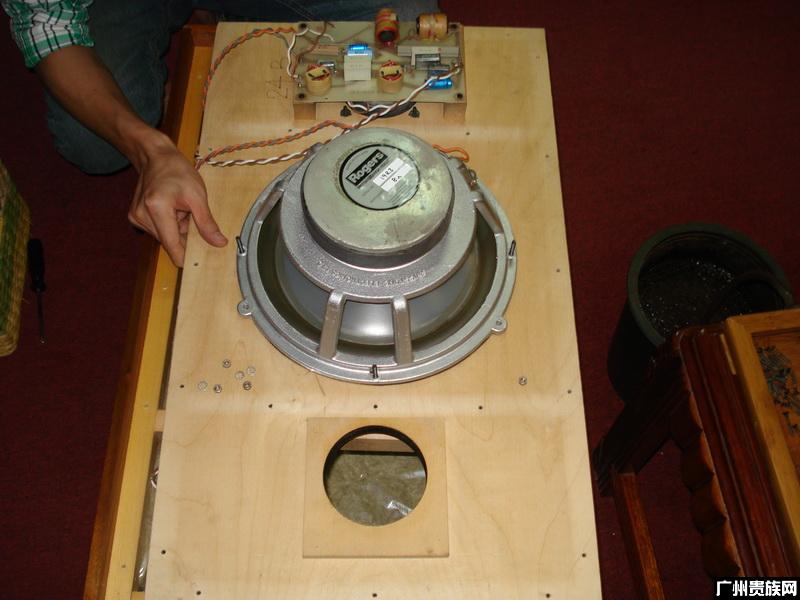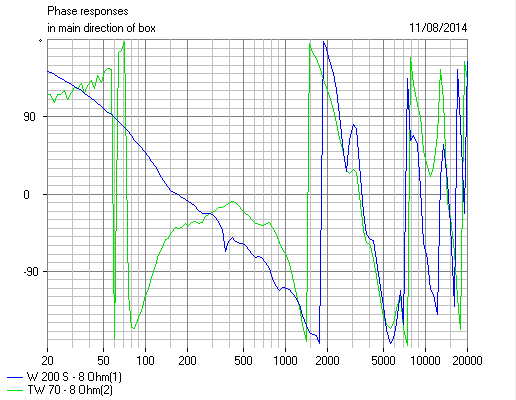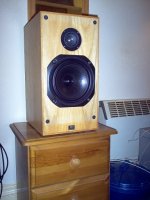Hi, i have a curiosity
I was looking at some British classic speakers like the Rogers PM510 S2

I have noticed that the woofer is mounted on the inside of the baffle
This is quite unusual .. is there a technical reason for this ?
Thanks and regards, gino
I was looking at some British classic speakers like the Rogers PM510 S2

I have noticed that the woofer is mounted on the inside of the baffle
This is quite unusual .. is there a technical reason for this ?
Thanks and regards, gino
Hi, i have a curiosity
I was looking at some British classic speakers like the Rogers PM510 S2
I have noticed that the woofer is mounted on the inside of the baffle
This is quite unusual .. is there a technical reason for this ?
Thanks and regards, gino
In fact it's quite the other way 🙂
Most speakers in the World are inside mounted 😱 , for the technical reason that it's easier to do so and any one can be mounted that way.
"Front mounting" requires :
a) a speaker frame which allows it, meaning it has a relatively wide lip or mounting "ears" which to boot provides a flat surface, which can be back gasketed.
As you know, 99.99% of speakers provide both (a flat gasketed lip all around) at the front 😉
Meaning practically all speakers are built so they can be mounted inside. 😱
b) some frame to support a front grill on its own, which allows its removal for mounting/unmounting speakers.

An inside speaker cabinet can have the front grill permanently stapled or glued, which is simpler and cheaper.
That said, front mounting is better, mainly because you lower edge diffraction, the resonance of the short tube you have in front (hole diameter and wood thickness), you improve dispersion a little, etc.
Not so bad in a woofer, but definitely hurts in a midrange or tweeter, so if you front mount 1 speaker ... you may as well front mount all. 🙂
Last edited:
In fact it's quite the other way 🙂
Most speakers in the World are inside mounted 😱 , for the technical reason that it's easier to do so and any one can be mounted that way.
"Front mounting" requires :
a) a speaker frame which allows it, meaning it has a relatively wide lip or mounting "ears" which to boot provides a flat surface, which can be back gasketed.
As you know, 99.99% of speakers provide both (a flat gasketed lip all around) at the front 😉
Meaning practically all speakers are built so they can be mounted inside. 😱
b) some frame to support a front grill on its own, which allows its removal for mounting/unmounting speakers.

An inside speaker cabinet can have the front grill permanently stapled or glued, which is simpler and cheaper.
That said, front mounting is better, mainly because you lower edge diffraction, the resonance of the short tube you have in front (hole diameter and wood thickness), you improve dispersion a little, etc.
Not so bad in a woofer, but definitely hurts in a midrange or tweeter, so if you front mount 1 speaker ... you may as well front mount all. 🙂
Hi and thanks a lot for the very kind and valuable reply
So there is no specific technical reason
I was thinking that with the woofer inside the box the cone is more free to move ... there is more "air" behind it
Instead with the woofer outside the edges of the hole can have an impact on the movement of the cone ?
As i said i saw this technique used by Rogers, Spendor and BBC speakers
But i know very well that British like to be original
Thanks again, gino
Do Magico mount their speakers on the inside? They soften the front edges to avoid diffraction
Hi and yes it seems so
I was thinking that in this way the edges of the hole can create less turbulence when the cone moves forward and backwards
I think that another feature of the Magico speakers is the extremely stiff front baffle, another nice thing
Thanks, gino
We've had this recessed bass question a lot of times. The reason you get away with it in BBC type designs is that if you wire negative polarity on the tweeter, and arrange the alignment error in the bass and tweeter at 2 to 3kHz crossover to be half a wavelength, which is 7.5 cm to 5 cm, the phase around crossover then aligns perfectly with big 8" to 12" drivers. 😎
6moons audio reviews: Harbeth M30.1
Harbeth (and myself) still do it. It sounds good. If you look at old relevant KEF and Rogers 3rd order crossover designs, you will see that the tweeter IS always wired negative polarity. Let's consider the additional 90 degree phase difference in 3rd order butterworth an added complication, strictly for the enthusiast...
6moons audio reviews: Harbeth M30.1
Harbeth (and myself) still do it. It sounds good. If you look at old relevant KEF and Rogers 3rd order crossover designs, you will see that the tweeter IS always wired negative polarity. Let's consider the additional 90 degree phase difference in 3rd order butterworth an added complication, strictly for the enthusiast...
Last edited:
Hi,
It requires a removable front or rear baffle, though some
BBC types have both. It allows a simple and thin grill.
FWIW most cheap boxes made nowadays have no
removable panels and drivers are front mounted,
usually, though exceptions through the bass
hole exist for for some mids, and rear press
fit tweeters in general - the latter usually
implying a 12mm thick front baffle.
rgds, sreten.
It requires a removable front or rear baffle, though some
BBC types have both. It allows a simple and thin grill.
FWIW most cheap boxes made nowadays have no
removable panels and drivers are front mounted,
usually, though exceptions through the bass
hole exist for for some mids, and rear press
fit tweeters in general - the latter usually
implying a 12mm thick front baffle.
An externally hosted image should be here but it was not working when we last tested it.
rgds, sreten.
We've had this recessed bass question a lot of times. The reason you get away with it in BBC type designs is that if you wire negative polarity on the tweeter, and arrange the alignment error in the bass and tweeter at 2 to 3kHz crossover to be half a wavelength, which is 7.5 cm to 5 cm, the phase around crossover then aligns perfectly with big 8" to 12" drivers. 😎
6moons audio reviews: Harbeth M30.1
Hi and thanks a lot. This is difficult.
So it is a specific design choice this placement of the woofer.
Very interesting.
Actually when i saw such a big woofer with a small tweeter i remained perplexed
Not a common choice ...
Harbeth (and myself) still do it. It sounds good.
If you look at old relevant KEF and Rogers 3rd order crossover designs, you will see that the tweeter IS always wired negative polarity. Let's consider the additional 90 degree phase difference in 3rd order butterworth an added complication, strictly for the enthusiast...
Very interesting. Actually these speakers have got very good reviews.
I tend to prefer paper for woofer cones ... but the answer is in the listening
I guess they are special polymeric cones ... i do not know
Thanks again, gino
Hi,
It requires a removable front or rear baffle, though some BBC types have both. It allows a simple and thin grill.
FWIW most cheap boxes made nowadays have no removable panels and drivers are front mounted, usually, though exceptions through the bass
hole exist for for some mids, and rear press fit tweeters in general - the latter usually implying a 12mm thick front baffle.
An externally hosted image should be here but it was not working when we last tested it.
rgds, sreten.
Hi and thanks and yes i asked because the mounting is quite unusual
As you say the vast majority of woofers (not only in cheap speakers) are front-mounted (Wilson Audio for instance, amd i would not call them cheap)
I did not understood completely the "phase" issue
But i have never understood phase in general ... i get lost with phase ...
Thanks again, gino
Good phase matching, or at least control of, makes for the drivers reinforcing each other at crossover, rather than cancelling each other out and creating a hole in the power response on axis.
I had a look at a flat baffle 8" woofer plus small tweeter on a BW3 (Butterworth 3rd Order filter) here:
http://www.diyaudio.com/forums/multi-way/190129-8-1-two-way-diy-speakers-11.html#post4016777
On the following page I looked at some other filter choices like LR4.
http://www.diyaudio.com/forums/multi-way/190129-8-1-two-way-diy-speakers-12.html#post4021676
The negative polarity principle applies to bigger woofers too, which otherwise would have lousy phase matching due to the deepness of the woofer and its acoustic centre.
I had a look at a flat baffle 8" woofer plus small tweeter on a BW3 (Butterworth 3rd Order filter) here:
http://www.diyaudio.com/forums/multi-way/190129-8-1-two-way-diy-speakers-11.html#post4016777
On the following page I looked at some other filter choices like LR4.
http://www.diyaudio.com/forums/multi-way/190129-8-1-two-way-diy-speakers-12.html#post4021676
The negative polarity principle applies to bigger woofers too, which otherwise would have lousy phase matching due to the deepness of the woofer and its acoustic centre.
Last edited:
PM510 is a Chartwell model number isn't it?
The Rogers version was called Studio 2a. Both were passive versions of the Rogers LS5/8. The difference is that the LS5/8 and PM510 had an Audax HD13D34H tweeter and the Studio 2A had a Celestion metal dome.
The Rogers version was called Studio 2a. Both were passive versions of the Rogers LS5/8. The difference is that the LS5/8 and PM510 had an Audax HD13D34H tweeter and the Studio 2A had a Celestion metal dome.
Good phase matching, or at least control of, makes for the drivers reinforcing each other at crossover, rather than cancelling each other out and creating a hole in the power response on axis.
I had a look at a flat baffle 8" woofer plus small tweeter on a BW3 (Butterworth 3rd Order filter) here:
http://www.diyaudio.com/forums/multi-way/190129-8-1-two-way-diy-speakers-11.html#post4016777
On the following page I looked at some other filter choices like LR4.
http://www.diyaudio.com/forums/multi-way/190129-8-1-two-way-diy-speakers-12.html#post4021676
The negative polarity principle applies to bigger woofers too, which otherwise would have lousy phase matching due to the deepness of the woofer and its acoustic centre.
Hi and thanks for the very interesting review
But as i said for me is very difficult to understand all this phase issue
You have attached this graph

I do not understand it. What does it show ? how can i read it ?
How should the "perfect" phase graph look like ?
The issue is very interesting but not straight for me
Thanks again, gino
PM510 is a Chartwell model number isn't it?
The Rogers version was called Studio 2a.
Both were passive versions of the Rogers LS5/8.
The difference is that the LS5/8 and PM510 had an Audax HD13D34H tweeter and the Studio 2A had a Celestion metal dome
Hi and thanks and yes i think you are right
I do not know about the sound differences
When i see a big woofer matched with a dome tweeter i am skeptical 🙄
But they say that the sound is really good, so ... 😱
Thanks again, gino
P.S. i would prefer the version with the Audax ... but i cannot say why
https://www.youtube.com/watch?v=uiOHq2_pHEw
Last edited:
Phase is the graph that people find hard.
http://www.diyaudio.com/forums/multi-way/190129-8-1-two-way-diy-speakers-12.html#post4021676
What it shows is the 8" woofer has a significant energy storage, aka cone breakup at 3kHz. That is the S-shaped kink in the phase. It is good to have rolled off the response significantly at that frequency to reduce its audibility.

Aligning phase well on Linkwitz-Riley 4th order (Steep 24dB per octave rolloff) is important too. It's probably the cleanest sounding filter around, with steep rolloff which just works well. BW3 (A shallower 18dB per octave) needs a lot of skill to do, because the phase has to be 90 degrees different between the drivers.
I never much like soft domes at all, preferring to use cone tweeters. You'd be hard pressed to find one that works down to 2kHz however, so a 10 or 12" bass would be hard to do.
http://www.diyaudio.com/forums/multi-way/190129-8-1-two-way-diy-speakers-12.html#post4021676
What it shows is the 8" woofer has a significant energy storage, aka cone breakup at 3kHz. That is the S-shaped kink in the phase. It is good to have rolled off the response significantly at that frequency to reduce its audibility.

Aligning phase well on Linkwitz-Riley 4th order (Steep 24dB per octave rolloff) is important too. It's probably the cleanest sounding filter around, with steep rolloff which just works well. BW3 (A shallower 18dB per octave) needs a lot of skill to do, because the phase has to be 90 degrees different between the drivers.
I never much like soft domes at all, preferring to use cone tweeters. You'd be hard pressed to find one that works down to 2kHz however, so a 10 or 12" bass would be hard to do.
Attachments
Last edited:
Hi and sorry sincerely for the late reply
I must confess ... i still do not "see" the issue from the graph but thank you anyway for trying to explain
It is not like a freq response .. a distortion spectrum ... a time alignment ... that i can see
This is very tricky ... every time there is a talk about phase i am lost
i do not know ... there are excellent speakers with soft domes
Like this ls5/8 and ls5/9 from Rogers ... i guess they use soft domes and the sound must be gorgeous
I tried to find the crossover frequency but i could not.
From what i have read the quality of the midrange makes or breaks the sound
Thanks a lot again.
Kind regards, gino
Phase is the graph that people find hard ...
I must confess ... i still do not "see" the issue from the graph but thank you anyway for trying to explain
It is not like a freq response .. a distortion spectrum ... a time alignment ... that i can see
This is very tricky ... every time there is a talk about phase i am lost
I never much like soft domes at all, preferring to use cone tweeters. You'd be hard pressed to find one that works down to 2kHz however, so a 10 or 12" bass would be hard to do
i do not know ... there are excellent speakers with soft domes
Like this ls5/8 and ls5/9 from Rogers ... i guess they use soft domes and the sound must be gorgeous
I tried to find the crossover frequency but i could not.
From what i have read the quality of the midrange makes or breaks the sound
Thanks a lot again.
Kind regards, gino
... I never much like soft domes at all, preferring to use cone tweeters.
You'd be hard pressed to find one that works down to 2kHz however, so a 10 or 12" bass would be hard to do
Hi and sorry again.
Could you please elaborate why you do not like soft domes ?
I mean ... it is just a matter of limited freq response in the lower Hz ?
I am trying to learn something because my future speaker will have a big woofer (8" or even 10" ) to get good bass without using a sub. This is firm.
Such woofers can only go up to 1kHz i guess.
I was thinking to use a 2" dome mid and a small dome tweeter to complete in the highs the response.
But your statement about domes makes me think.
Maybe a cone mid would be a better option ?
Thanks and regards, gino
Last edited:
I had Harbeth HLs that were inner mounted. My only gripe was that the ply wood edge showed. In contrast to the walnut veneer it uglified them up somewhat. But small price to pay for fantastic sounding speakers though
question? what would happen to the phase response if the position of the drivers in the BBc 510 where swapped as in tweeter mounted to the inside of the baffle and woofer on the outside assuming an average baffle thickness of 3/4 inch?
I had Harbeth HLs that were inner mounted.
My only gripe was that the ply wood edge showed.
In contrast to the walnut veneer it uglified them up somewhat.
But small price to pay for fantastic sounding speakers though
Hi i think i could live with even the ugliest speaker around as long as the sound is fantastic.
I also listen usually in the dark to avoid visual distractions.
Another option is to listen blindfolded. The difference can be impressive.
Regards, gino
- Status
- Not open for further replies.
- Home
- Loudspeakers
- Multi-Way
- Woofers mounted from the inside
